This post may contain affiliate links. If you use these links to buy something we may earn a commission. Thanks.
Wine caps, otherwise known as “Garden Giant” or King Stropharia, are the easiest mushrooms to buy, grow, and use!
All they need to grow is wood mulch or straw, and are suitable in the sun or shade.
Next thing you know, your mulch is as productive as your plants!
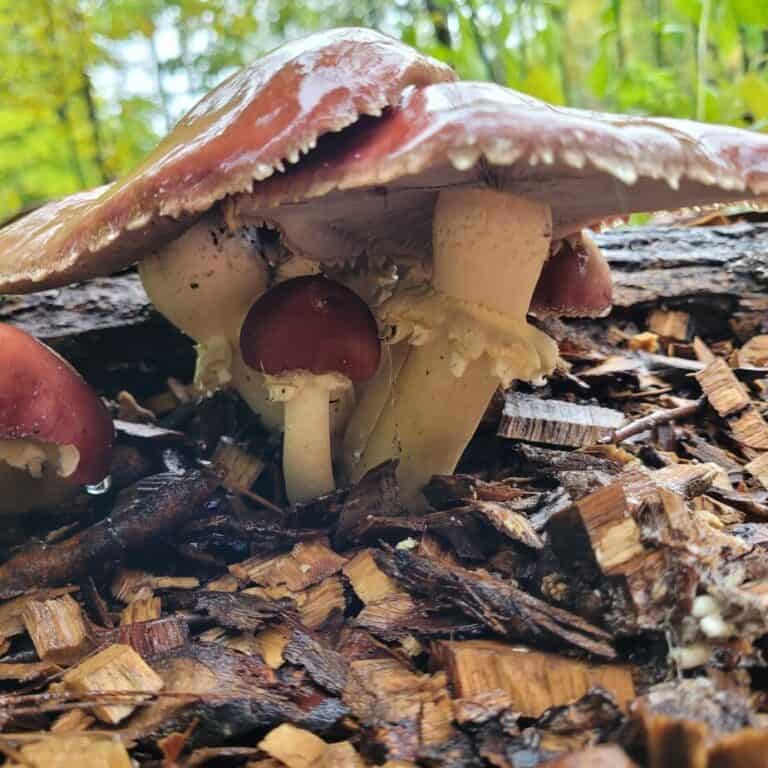
When we inoculated our first bed of wine caps about 6 years ago, we were in it for a high volume of mushrooms! Little did we know, we began seeing the gorgeous living soil that they left behind.
Their compost has been amazing for all of our perennial plants, and what’s even better, is they’re still popping up after every rainfall. Not only are they easy to grow, but are a very passive, low-maintenance, and nutrient-rich food source that keeps coming back!
All it took was a bag of ‘Garden Giant’ sawdust spawn, 2-8 months of time after that, and adding a new bit of wood mulch each year.
Current discounts are given using QUALITYSPAWN if you haven’t already gotten spawn yet!
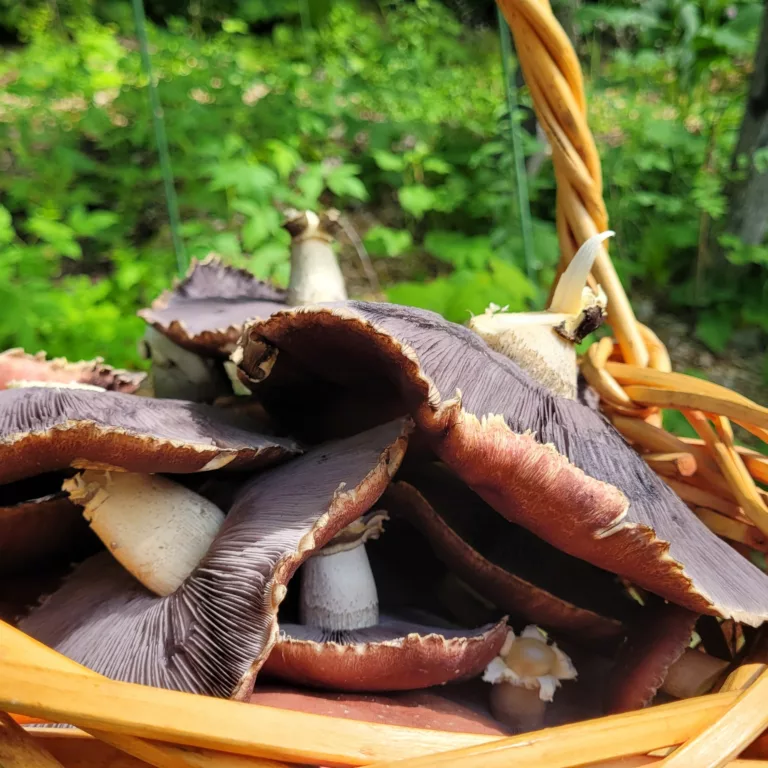
Before you dig into all the answers to your questions below, let’s clear up what constitutes “wine caps” as this prolific mushroom is known by many names!
Stropharia rugosoannulata is the scientific name of wine cap mushrooms and the common names include garden giant, wine caps, burgundy mushrooms, king Stropharia, and Godzilla mushroom.
To use your wine caps you’ll want to know what they’re like, taste and texture-wise, and perhaps see some inspiring recipes or pursue your own kitchen creativity! We’ll explore everything below.
Contents:
- Natural Habitat and Range of Wine Caps
- How to Grow Wine Caps
- Harvesting and Storage
- Ecological Benefits
- Wine Cap Companion Planting
- How to Use Wine Caps
- Nutritional Value and Health Benefits
- Identification and Look-a-likes
Natural Habitat and Range of Wine Caps
Understanding the natural habitat and range of wine caps will help you decide if this mushroom is a good fit to grow in your climate!
- The range consists of regions that have favorable conditions.
- The habitat consists of where it tends to grow and what it needs to grow in an appropriate region.
With years of experience in growing wine cap mushrooms, I’ve seen, verified, and answered the most common questions about their environmental preferences. And as beginners, we had all these same questions, but wished for a simple set of answers at the time!
So here you go:
1. Where do wine caps grow?
Northeast North America is where King Stropharia mushrooms grow natively. The northeast areas are abundant with hardwood forests—their favorite food. Anyone, however, residing in any part of North America can easily grow them with the right materials and conditions!
2. Do wine caps survive winter?
All mushrooms survive, grow, and fruit in various conditions and growing zones depending on species preference, and wine caps have unique temperature ranges.
Wine cap mycelium has demonstrated survival in Zone 3 with temperatures down to -50 to -40 degrees °F (-46 to -40°C). The mycelium lives through freezing and to ensure survival in frigid climates, simply place your mushroom bed in an area that receives snow and mulch the area every autumn.
Snow keeps the mycelium (vegetative body of the wine cap mushrooms) moist and warmer and the mulch maintains moisture retention and warmth as snow thaws and freezes as spring approaches.
3. Wine cap mushroom growing temperature
Wine caps grow best in warmer temperatures that are above freezing. Fruiting, however, occurs in a specific range!
50-70°F (10-21°C) is the optimal fruiting temperature range for wine cap mushrooms. With the combination of these temperatures and rainfall, you’re sure to find large flushes of wine cap mushrooms for dinner that day or the next.
4. Do King Stropharias like sun or shade?
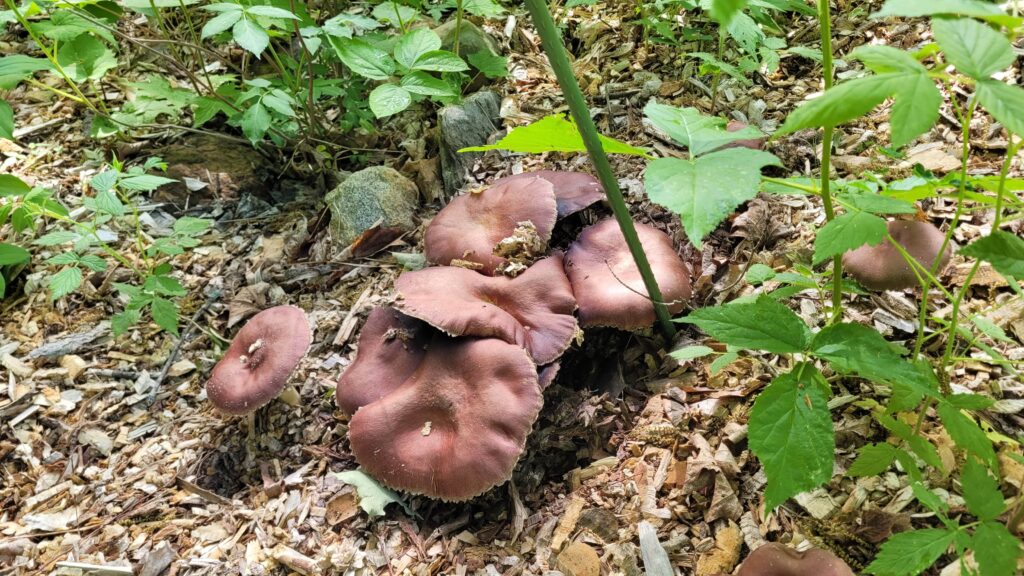
The greatest thing gardeners love about wine cap mushrooms is their ability to tolerate various levels of sunlight!
Partial shade with bright indirect light is the best choice for wine cap mushrooms, but they can also grow just as well in shade or full sun. A full sun placement works as long as the bed does not dry out and a shade placement works as long as it receives snow.
Partial shade placement is a win-win for the mushroom and the grower—these areas tend to receive plenty of rain and snow and the lack of excessive sunlight keeps the moisture in the mulch.
5. What is the King Stropharia habitat?
King Stropharia mushrooms grow and show up wherever they find their favorite food.
A hardwood forest floor is the natural habitat of wine cap mushrooms as their favorite food source is fresh woody debris, leaves, and dead grasses. Hardwood provides the ideal type of debris as it falls more often than softwood trees and contains less antifungal sap.
Anyone can recreate this habitat using woodchips, leaves, and straw. Gardeners are growing this North American species in Australia, New Zealand, England, and more using fresh local woody and grassy carbon materials.
With the right mulch material, you aren’t limited to growing wine cap mushrooms only. Wine caps are the easiest to grow in wood chip beds, but other species like oysters are also very beginner-friendly.
For more options, see: 6 Best Mushrooms for Woodchip Beds
How to grow Stropharia Rugosoannulata (Wine Caps)
Overall, Wine Cap Stropharia is the easiest most carefree mushroom to set up and grow continuously.
You can ‘plant’ them directly on the ground, in a raised bed, or large container with the right timing and layering of materials.
Between May and September, lay a bed of straw or multiple sheets of newspaper in the chosen 3’x3′ area. Then crumble a quarter of your sawdust spawn onto the bed and water it. Alternate layers of woodchips, spawn, straw, and water to reach a 4-6 inch thickness and end with 1 inch of mulch.
Water your wine cap bed as often and deeply as you’ll water your garden, and be careful not to drench or drown the bed, as mycelium also needs air to breathe!
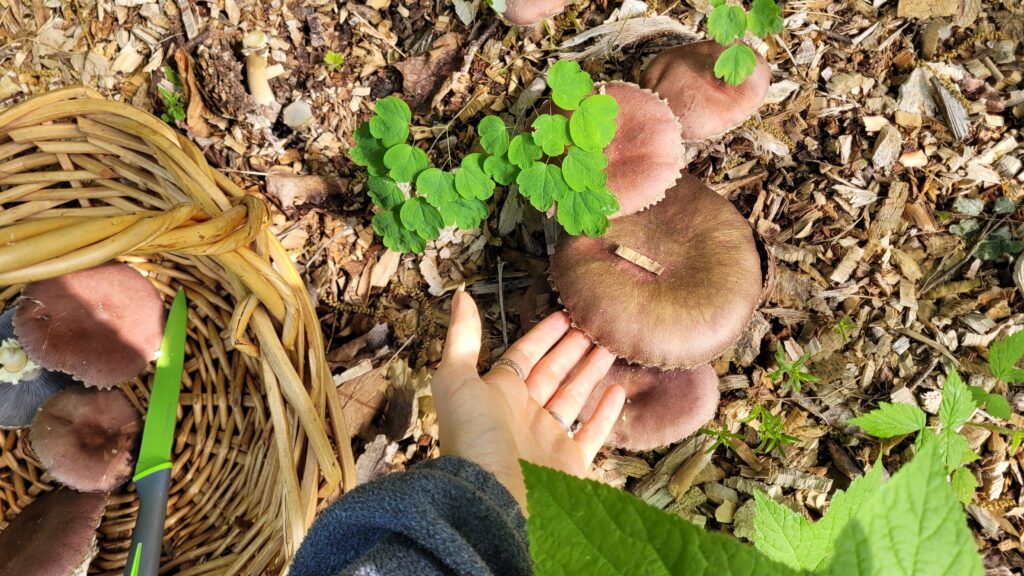
Your bed will be crawling its ‘roots’ (mycelium) around and colonizing the material you layered. Once finished colonizing, wine caps will pop up in clusters as the temperature and moisture levels are right.
It takes 2-8 months to see wine cap mushrooms from the day of planting. If you make a mushroom bed in spring, you’re likely to get wine caps in autumn. If you make a wine cap bed in autumn you may see wine caps in spring!
Be out on the lookout for King Stropharia mushrooms when temperatures are 50-70°F (10-21°C).
Best substrates to grow Wine Caps
Although it isn’t hard to mess up, the right materials can also go a long way for success with wine caps.
Our wine caps have shown to grow best in a mixture of fresh hardwood chips and organic oat straw. But lucky for everyone, wine caps aren’t picky eaters—you can use a range of carbon materials and get good results.
| Best | Good | Mix |
| Hardwood chips | Softwood chips | Leaves |
| Organic oat straw | Old woodchips | Paper |
| Organic wheat straw | Spoiled organic straw | Cardboard |
| Fresh mixed woodchips | Bark mulch | Sawdust |
Combining a mixture of materials creates a more moisture-retentive mushroom bed as varying particle sizes tend to sit closer together. And a moisture-retentive mushroom bed means less maintenance for you!
Just getting started with mushrooms? learn the foundations: Grow a Mushroom Garden at Home in 4 Steps
Harvesting tips for wine cap mushrooms
Harvesting wine cap mushrooms is pretty straightforward, but a few pointers can help with quality, storage, texture, and taste!
- The more often you walk through your garden, the more you’re likely to harvest from it!
This tip applies to vegetables, fruits, and mushrooms! New wine caps can pop up out of nowhere in a short time so diligence will allow you to beat the bugs.
It’s completely normal for bugs to eventually ‘get’ your mushrooms, so keeping a close watch while they are fresh is key!
And I’ll say it once more, between 50-70°F (10-21°C) is the best temperature range to keep a closer watch!
- Harvest wine caps when young and mature
Wine caps are often harvested as they are found. But you might discover that you prefer young wine caps over mature ones, or vice versa. Personally, we don’t have a preference.
The big caps turn out nice on the barbeque or air fryer, and the small caps are firmer to enjoy chopped up in a pan and sauteed.
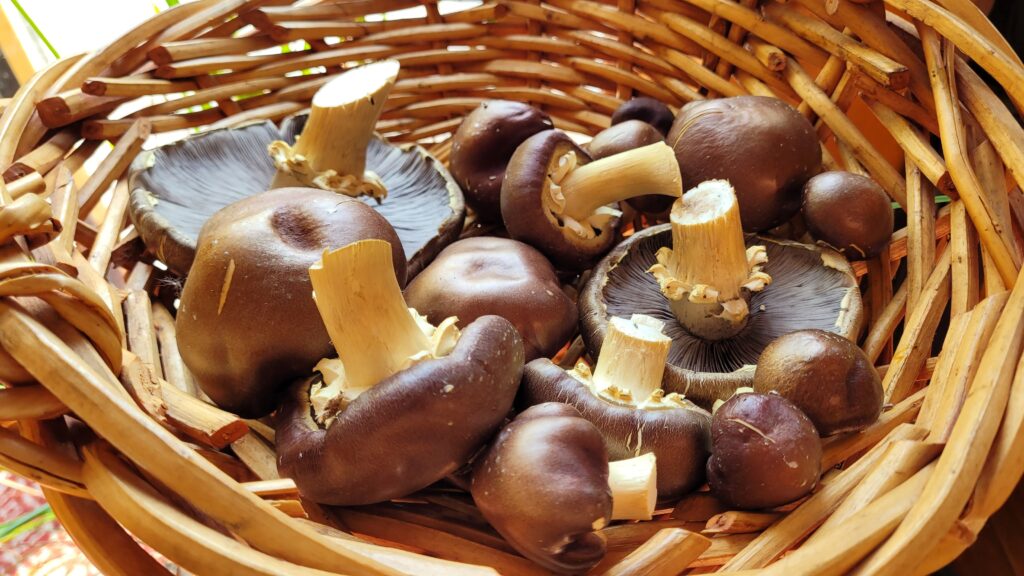
- Harvest wine caps with or without the stem
If you’ve never tried wine caps, cut the stem low to harvest your stems and taste them cooked. Compare the cap and stem to see what you like.
Personally, I’m not a fan of the stems, but many people are!
- Use a knife to cut the stems
Cutting the stems clean with a sharp knife prevents disruption to the mulch. While not critical for this mushroom species, if you can avoid lifting and disturbing the mulch then more moisture can be retained in the bed.
How do you store wine caps?
You’re most likely to find wine caps the day after a good rain, and the best time to harvest them for storage purposes is after they have had a chance to air dry.
In general, mature wine caps keep for a week in the refrigerator, and young button wine caps keep for up to 2 weeks. Alternatively, you can cook them right away and freeze them for 6-8 months.
They cook better and store for longer when found dry outdoors. But you can also dry wet mushrooms yourself by laying them on a paper towel with a fan.
If found fresh and dry you can pop them into the fridge without any further effort to clean and dry them manually.
It isn’t necessary to wait for them to be dried by the breeze, but they are very clean when the opportunity comes around.
Drying Wine Cap Mushrooms
Drying wine cap mushrooms is an easy process and is a common storage method for those with full freezers!
To dry wine caps, gently clean dirt or debris off with the pads of your fingers or a damp paper towel. Cut thin slices and space them on the dehydrator rack in a single layer. Set the temperature at 125°F (52°C) for 3-8 hours. They should be brittle and break when fully dried, without a bend.
Do mushrooms need to be blanched before dehydrating?
You don’t need to blanch wine cap mushrooms before dehydrating them. It is, however, best to cook them before freezing.
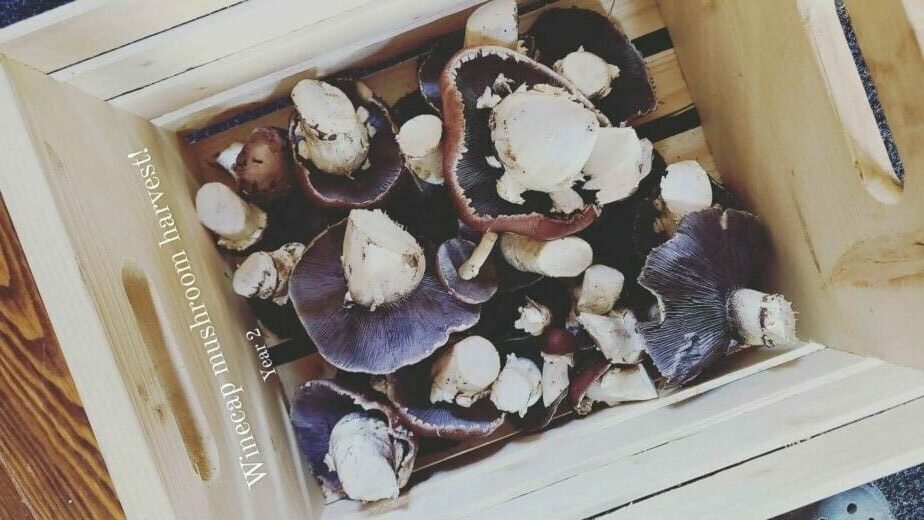
Ecological Benefits of Wine Caps
One of the primary reasons gardeners introduce wine caps to their landscape is to create rich compost and protect plants!
Compost:
In a garden, bacteria and fungi are actively working to break down organic matter into available nutrients for plants.
Wine caps are a wood-loving species that is excellent at breaking down woody material at a relatively quick pace! They basically transform woodchips into fertile soil!
The ‘black gold’ left behind by the wine caps in our garden has certainly benefited our food forest. Not only has the companion planting been bountiful, but including a pile of wood mulch really gets me excited.
Once you have a patch of wine caps, you can take a handful of its mycelium from one pile to another to propagate it in a new area.
Plant protection:
Wine caps produce ‘acanthocytes‘ which consume nematodes that may be destructive to root crops. So while harvesting root crops isn’t ideal for your mushroom bed, the presence of the mushrooms is ideal for growing those satiating root crops!
The overall benefit of wine caps in your ecosystem is the mutual relationship between them, and your plants!
With the right companion planting, they can feed each other, too.
Wine Cap Companion Planting
See: Wine Cap Mushroom Companion Planting (Full Guide)
Flavor of wine cap mushrooms
King Strophoria mushrooms have a unique taste, somewhat related to their name!
The caps are reminiscent of an oaked red wine but mild like a potato. Mature caps are soft and melty in the mouth while young caps are firmer with a bit of a bite. Very mature wine caps often fade to a beige-brown color, are milder in flavor, softer, and are still completely edible.
The stems of wine caps chew like asparagus but have a mild mushroomy taste. Older stems, however, become tougher and more stringy to eat. Overall, the older they get the less desirable to the palette they are.
How to use wine cap mushrooms in the kitchen
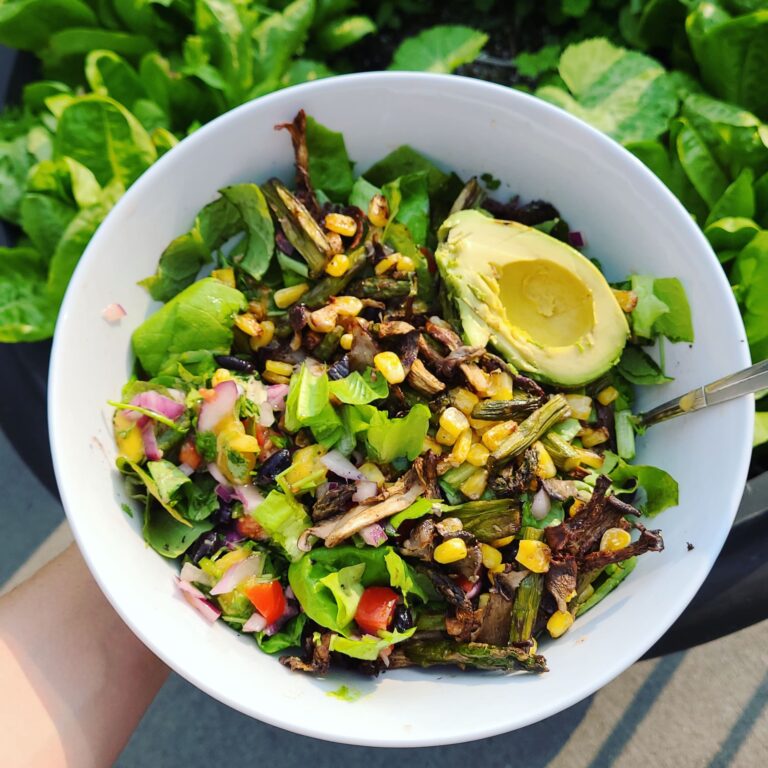
Wine caps aren’t generally a ‘favorite’ mushroom, but the way you cook them can make all the difference!
Whole caps without stems or uniform slices of the caps, with or without the stems, are the most common ways to prepare wine caps for cooking. Sometimes, stem lovers will cook stems whole or chopped as disks.
Once prepared, sautee with garlic, salt, and butter, coconut, or olive oil—the most classic and easy way to eat wine caps. You can also coat mushrooms in olive oil and put them on the barbeque, in the oven on a baking sheet, or in the air fryer.
The stems tossed in oil and air-fried will be most like asparagus in experience. Whole caps can be eaten as burgers and sliced, added as a side, or topped onto anything, including salads!
If you didn’t or don’t like wine cap mushrooms, you most likely didn’t cook them for long enough. The biggest complaint is soggyness. Wine caps have a lot of water (on average fresh wine caps are about 92% water!), so extra cooking time or dehydration is key to a texturally appealing experience.
With longer cooking time, flavors also become more concentrated and that includes what you sautee with it!
For other tasty mushrooms you can grow, see: 9 Best-Tasting Mushrooms to Grow & What They’re Like
Health benefits of wine caps
Not only do wine caps benefit your garden, they benefit you! Various compounds that contribute to our health have been found in wine caps.
Benefits such as healthy bones and a strong immune system are the tip of the iceberg since wine caps are rich in eight essential amino acids and various B vitamins including cobalamin (B12), and vitamin D2 when exposed to sunlight. With quality substrate, wine caps can be rich in zinc and selenium. (Source)
With a wide spectrum of nutrients, wine caps are a healthy addition to any diet. While wine caps have potential benefits, they are not a substitute for professional medical advice.
Edible mushrooms are generally health foods, but several kinds are not only deliciously gourmet but highly medicinal!
See: 4 Easy Medicinal Mushrooms to Grow for Healing
Up Next: 6 Steps to Identify Wine Cap Stropharia + Lookalikes
Recent Posts
There’s no shortage of full-sun ground covers for zone 4 climates! Each plant in this list can withstand the frigid temperatures and also enjoy the hot sun in summer. Full sun means that a plant...
There's no shortage of full sun ground covers, not even in zone 3! Zone 3 climates offer hot but short-lived summers and very cold winters. So each plant in this list can withstand the frigid...
